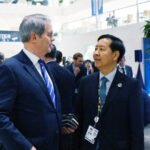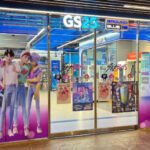SK Hynix’s DRAM plant in Icheon
SK Hynix Inc., the world’s second-largest memory chipmaker after Samsung Electronics Co., said on Thursday it has made a significant turnaround in the second quarter with record quarterly sales and its highest operating profit in six years.
The South Korean chipmaker also said its NAND business posted strong profits for the second consecutive quarter sequentially, buoyed by eSSD, a premium product.
SK Hynix said in a regulatory filing that it posted 5.5 trillion won ($4 billion) in second-quarter operating profit on a consolidated basis, a turnaround from a loss of 2.9 trillion won in the year-earlier period.
The operating profit, aligned with market expectations, is the highest since the third quarter of 2018 when it posted a profit of 6.5 trillion won amid the chip super cycle.
The operating profit margin was 33%, up 10 percentage points from the previous quarter.
(Graphics by Dongbeom Yun)
Sales more than doubled to 16.4 trillion won – the company’s all-time high quarterly revenue.
Net profit was 4.1 trillion won, turning from a loss of 3 trillion won a year earlier.
The company attributed its spectacular results to robust sales of its premium products for artificial intelligence, including high bandwidth memory (HBM) chips, and increased demand for high-end NAND flash memory chips.
“HBM sales went up by over 80% compared to the previous quarter and over 250% from a year ago,” SK Hynix said in a statement.
For the NAND business, the sale of eSSD increased by about 50% from the first quarter, it said. The average selling price has steadily risen across its NAND products since the fourth quarter of last year.
SK Hynix’s HBM3E, the extended version of the HBM3 DRAM chip
TOP BENEFICIARY OF HBM BOOM
Among memory chipmakers, SK Hynix is the biggest beneficiary of the explosive increase in AI adoption, as it dominates the production of HBM, critical to generative AI computing and is the top supplier of AI chips to Nvidia Corp., which controls 80% of the AI chip market.
To hold its lead, it joined hands with Taiwan Semiconductor Manufacturing Co. (TSMC), the world’s top contract chipmaker, in April to develop next-generation AI chips, called HBM4.
SK Hynix started producing fifth-generation HBM chips, HBM3E, in March, with initial shipments going to Nvidia.
Sources said it will begin mass production of the 12-layer HBM3E chip in the third quarter and begin supplying them in large quantities to Nvidia in the fourth quarter.
A rendering of SK Hynix’s M15X fab (Courtesy of Yonhap)
Samsung, which has passed Nvidia’s qualification tests for its HBM3 chips, is striving to gain the US AI chip designer’s approval for its HBM3E chips, sources said.
In May, SK Hynix Chief Executive Kwak Noh-Jung said its HBM chips were sold out for this year and its capacity is almost fully booked for 2025.
Q3 OUTLOOK
SK Hynix said it expects the overall memory market to be on a steady growth path in the second half as demand for AI memory continues to rise, while supplies for conventional DRAM and NAND are also becoming tight.
The company said it plans to launch 32 gigabit (Gb) DDR5 DRAM for servers and MCRDIMM, a multiple DRAM module for high-performance computing, in the second half.
SK Hynix said it expects Cheongju M15X, an advanced DRAM chip plant currently under construction, to start mass production in the second half of next year.
SK Hynix’s HBM3E AI chip supplied to Nvidia
Separately, construction of its first fab at Korea’s Yongin semiconductor cluster will begin in March next year for completion in May 2027.
While it expects its annual capital expenditure to be higher than planned earlier this year, executives said the company will closely monitor customer demand and market trends to maintain its financial soundness.
“We were able to reduce our borrowings by 4.3 trillion won compared to the first quarter while continuing to make essential investments,” said Chief Financial Officer Kim Woo-hyun. “We will solidify our position as the AI chip leader based on a stable financial structure.”
By Jeong-Soo Hwang
hjs@hankyung.com
In-Soo Nam edited this article.















